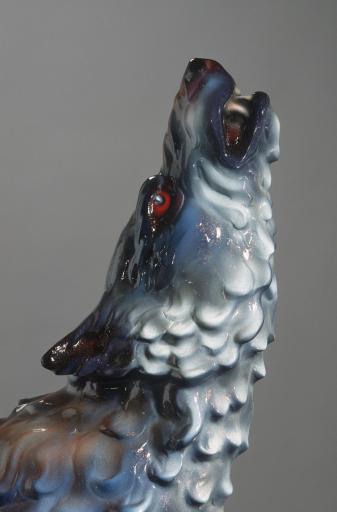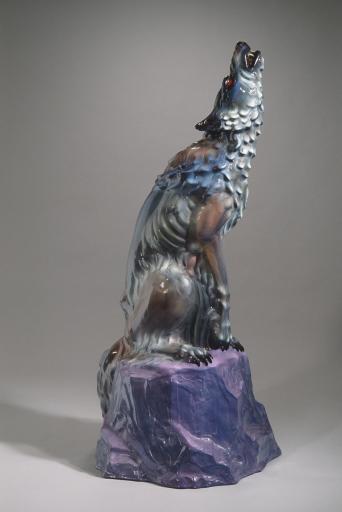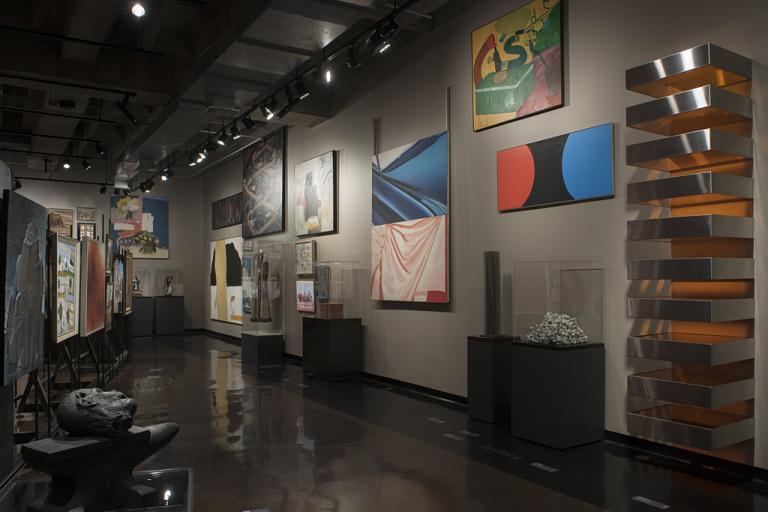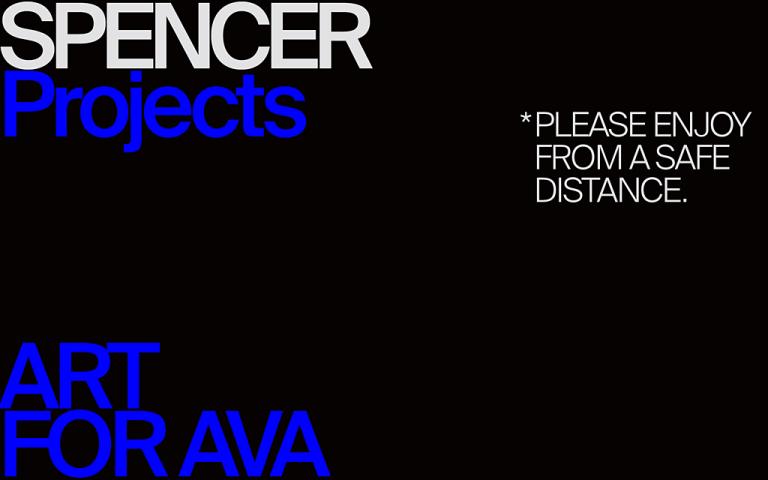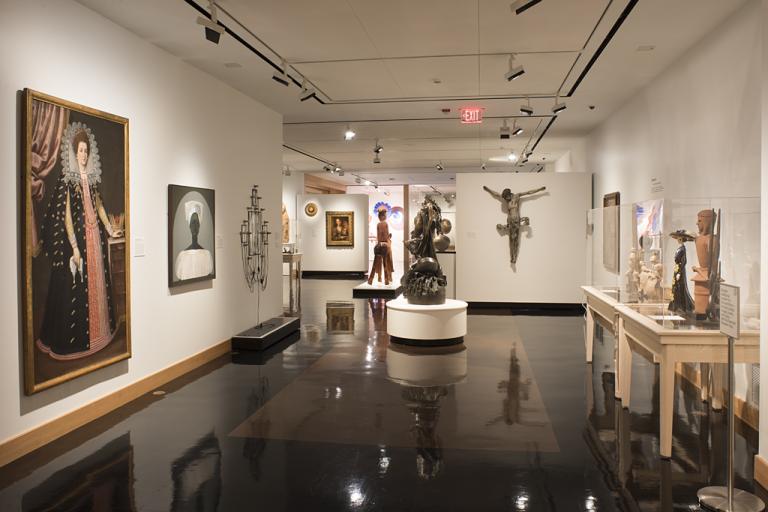Howl, Luis Alfonso Jimenez
Artwork Overview

Object Height/Width/Depth (Height x Width x Depth): 60 x 36 x 36 in
Object Height/Width/Depth (Height x Width x Depth): 152.4 x 91.4 x 91.4 cm
If you wish to reproduce this image, please submit an image request
Images
Label texts
This fiberglass sculpture by Mexican-American artist Luis Jimenez evokes the lonely cry of a wolf howling at a full moon. Born in El Paso, Texas, Jimenez often used imagery like a howling wolf to explore the historic and contemporary collision of cultures along the border between the United States and Mexico. Howl resonates with the tensions between a humanized landscape and the wild.
This fiberglass sculpture by Mexican-American artist Luis Jimenez evokes the lonely cry of a wolf howling at a full moon. Born in El Paso, Texas, Jimenez often used imagery like a howling wolf to explore the historic and contemporary collision of cultures along the border between the United States and Mexico. Howl resonates with the tensions between a humanized landscape and the wild.
Take a look at photographs of this sculpture from different angles. What do you see that is realistic about this rendering of a creature? What about this creature is not realistic? This sculpture is partly inspired by the Mexican wolf, an animal that used to live on the border of Mexico and the United States. The Mexican wolf migrated between the two countries to find food.
About the art
This sculpture is made from fiberglass, the same kind of material that is used to make the bodies of cars, boats, surfboards, and many other things.
About the animal
The Mexican wolf is the most endangered land mammal in North America. Only about 80 Mexican wolves remain in the wild.
Click the link below to see a photograph of a Mexican wolf similar to this one.
Remember to walk all around the sculpture to see every side of it. What do you see that is realistic about this creature? What about this creature is not realistic? This creature is partly inspired by the Mexican wolf, an animal that used to live on the border of Mexico and the United States. The Mexican wolf migrated between the two countries to find food.
About the art
This sculpture is made from fiberglass, the same kind of material that is used to make the bodies of cars, boats, surfboards, and many other things.
About the animal
The Mexican wolf is the most endangered land mammal in North America. Only about 80 Mexican wolves remain in the wild.
Tap the Web icon to see a Mexican wolf similar to this one.
This tour begins in the exhibition, The Object Speaks, which examines the ways in which objects can carry and convey meaning through time. What kinds of meaning does this sculpture convey to you?
Driving from Roswell to Santa Fe one night, Luis Alfonso Jiménez came across an injured coyote in the road howling in pain. After putting the creature out of its misery, he took the coyote’s body home and studied it. Jiménez created a lithograph print based on the coyote. Tap on the Related icon to view this print. The image of the injured animal remained a source of inspiration, evolving into this fiberglass representation of the nearly extinct Mexican wolf. The creature’s red eyes are a reference to the animal forms Jiménez’s father made in his neon sign shop and the metallic-flaked fiberglass references Chicano lowrider car culture in the American Southwest.
How can artists use cultural traditions or experiences to inspire or express meaning in their work?
This tour begins in the exhibition, The Object Speaks, which examines the ways in which objects can carry and convey meaning through time. What kinds of meaning does this sculpture convey to you?
Driving from Roswell to Santa Fe one night, Luis Alfonso Jiménez came across an injured coyote in the road howling in pain. After putting the creature out of its misery, he took the coyote’s body home and studied it. Jiménez created a lithograph print based on the coyote. The image of the injured animal remained a source of inspiration, evolving into this fiberglass representation of the nearly extinct Mexican wolf. The creature’s red eyes are a reference to the animal forms Jiménez’s father made in his neon sign shop and the metallic-flaked fiberglass references Chicano lowrider car culture in the American Southwest.
How can artists use cultural traditions or experiences to inspire or express meaning in their work?
Click on the audio tab above to listen to a student's interpretation of this object.
“You have to remember that I grew up as a Mexican in Texas….Growing up on the border in El Paso, which some people have said is not really quite in the United States, the Mexican, or the Spanish thing was important, and so going to Mexico was an important kind of pilgrimage for me.
“In fact, I thought I was going to stay there and live. When I got down to Mexico, I realized that I was an American. My whole way of thinking, my framework, etc., is American. I am an American of Mexican descent….It’s an important thing to realize….”
- Luis Jimenez
Luis Jimenez, interviewed by Peter Bermingham in Tucson, Arizona, December 15 and 17, 1985. Smithsonian Archives of American Art.
Luis Jimenez applied the vivid symbolism and color imagery of pre- and post-Contact Mexico to an array of artistic media, most notably his lithographs and sculptures. His works evoke the essence of the historic and contemporary collision of cultures in the U.S.-Mexico border region and the tension between the humanized landscape and the wild. The sensuality of his characters, both human and animal, is almost overwhelming; they writhe with passion, you can smell and hear them, feel their strength, sense their weakness. One has the feeling that here was a man you would like to have walked or rode with for some distance to no place in particular; talking, but mainly listening, about his impressions of and concern for the passing scenes.
- Bill Woods, Professor of Geography
Didactic label content here.
“You have to remember that I grew up as a Mexican in Texas….Growing up on the border in El Paso, which some people have said is not really quite in the United States, the Mexican, or the Spanish thing was important, and so going to Mexico was an important kind of pilgrimage for me.
“In fact, I thought I was going to stay there and live. When I got down to Mexico, I realized that I was an American. My whole way of thinking, my framework, etc., is American. I am an American of Mexican descent….It’s an important thing to realize….”
- Luis Jimenez
Luis Jimenez, interviewed by Peter Bermingham in Tucson, Arizona, December 15 and 17, 1985. Smithsonian Archives of American Art.
Luis Jimenez applied the vivid symbolism and color imagery of pre- and post-Contact Mexico to an array of artistic media, most notably his lithographs and sculptures. His works evoke the essence of the historic and contemporary collision of cultures in the U.S.-Mexico border region and the tension between the humanized landscape and the wild. The sensuality of his characters, both human and animal, is almost overwhelming; they writhe with passion, you can smell and hear them, feel their strength, sense their weakness. One has the feeling that here was a man you would like to have walked or rode with for some distance to no place in particular; talking, but mainly listening, about his impressions of and concern for the passing scenes.
- Bill Woods, Professor of Geography
“You have to remember that I grew up as a Mexican in Texas….Growing up on the border in El Paso, which some people have said is not really quite in the United States, the Mexican, or the Spanish thing was important, and so going to Mexico was an important kind of pilgrimage for me.
“In fact, I thought I was going to stay there and live. When I got down to Mexico, I realized that I was an American. My whole way of thinking, my framework, etc., is American. I am an American of Mexican descent….It’s an important thing to realize….”
- Luis Jimenez
Luis Jimenez, interviewed by Peter Bermingham in Tucson, Arizona, December 15 and 17, 1985. Smithsonian Archives of American Art.
Luis Jimenez applied the vivid symbolism and color imagery of pre- and post-Contact Mexico to an array of artistic media, most notably his lithographs and sculptures. His works evoke the essence of the historic and contemporary collision of cultures in the U.S.-Mexico border region and the tension between the humanized landscape and the wild. The sensuality of his characters, both human and animal, is almost overwhelming; they writhe with passion, you can smell and hear them, feel their strength, sense their weakness. One has the feeling that here was a man you would like to have walked or rode with for some distance to no place in particular; talking, but mainly listening, about his impressions of and concern for the passing scenes.
- Bill Woods, Professor of Geography
Exhibition Label: “Conversation I: Place,” Oct-2007, Emily Stamey
“You have to remember that I grew up as a Mexican in Texas….Growing up on the border in El Paso, which some people have said is not really quite in the United States, the Mexican, or the Spanish thing was important, and so going to Mexico was an important kind of pilgrimage for me.
“In fact, I thought I was going to stay there and live. When I got down to Mexico, I realized that I was an American. My whole way of thinking, my framework, etc., is American. I am an American of Mexican descent….It’s an important thing to realize….”
- Luis Jimenez
Luis Jimenez, interviewed by Peter Bermingham in Tucson, Arizona, December 15 and 17, 1985. Smithsonian Archives of American Art.
Luis Jimenez applied the vivid symbolism and color imagery of pre- and post-Contact Mexico to an array of artistic media, most notably his lithographs and sculptures. His works evoke the essence of the historic and contemporary collision of cultures in the U.S.-Mexico border region and the tension between the humanized landscape and the wild. The sensuality of his characters, both human and animal, is almost overwhelming; they writhe with passion, you can smell and hear them, feel their strength, sense their weakness. One has the feeling that here was a man you would like to have walked or rode with for some distance to no place in particular; talking, but mainly listening, about his impressions of and concern for the passing scenes.
- Bill Woods, Professor of Geography
Exhibitions
Kate Meyer, curator
Celka Straughn, curator
Kate Meyer, curator
Celka Straughn, curator
